Psychology Counseling Models: Social Construction and Therapy
VerifiedAdded on 2023/01/23
|6
|1116
|80
Essay
AI Summary
This essay provides an overview of several key psychology counseling models. It begins by explaining narrative therapy, which views individuals separately from their problems, encouraging them to create new perspectives and change their behaviors. The essay then discusses behavioral and cognitive-behavioral models, which examine how thoughts, feelings, and behaviors interact, and how negative thoughts can lead to psychological distress. This section highlights how these therapies help individuals develop alternative thinking and behavior patterns. Finally, the essay explores social construction models, focusing on solution-focused and collaborative therapies, which emphasize change and actively involve both the therapist and the patient in finding solutions. The essay references several scholarly articles to support its discussion of these different therapeutic approaches.
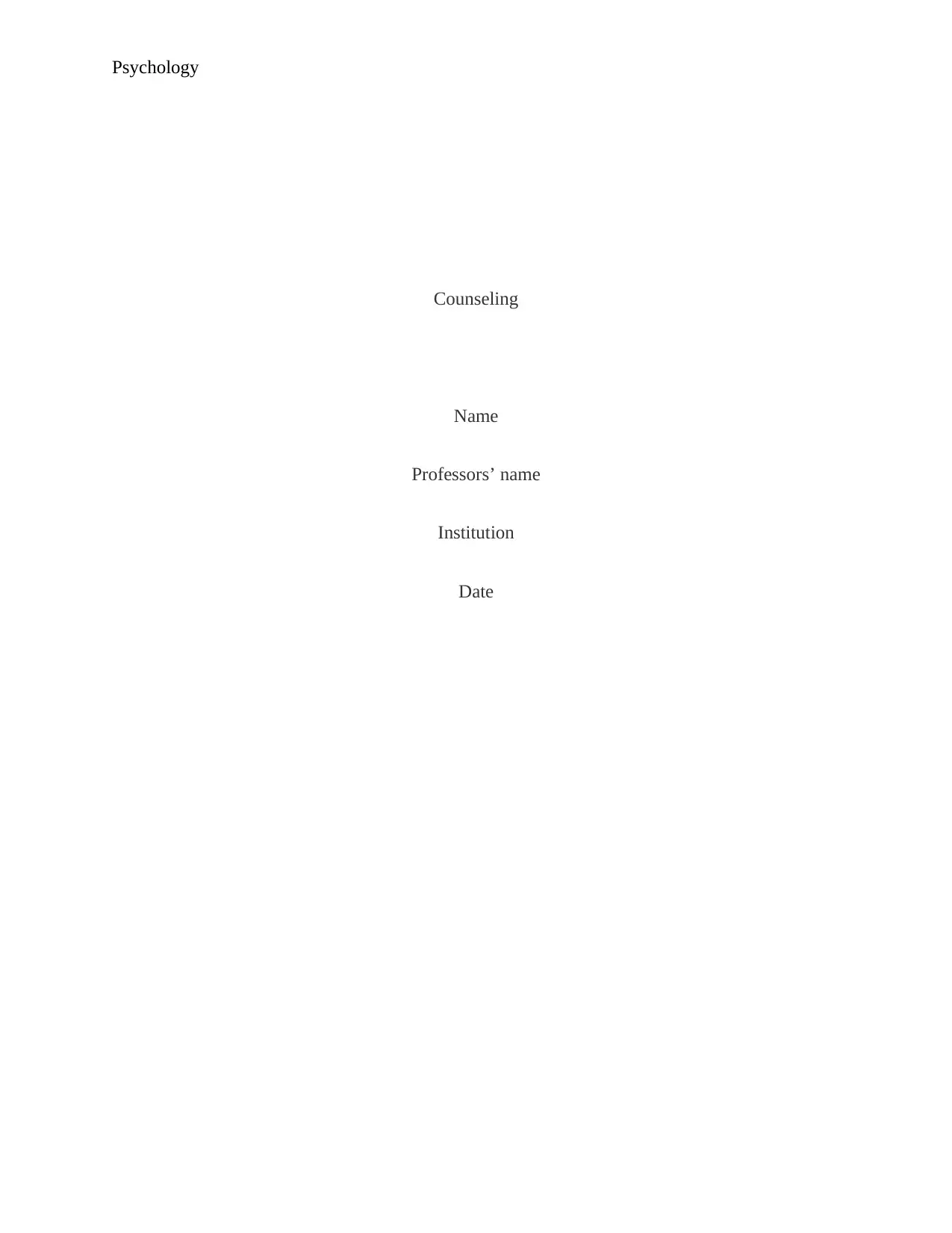
Psychology
Counseling
Name
Professors’ name
Institution
Date
Counseling
Name
Professors’ name
Institution
Date
Paraphrase This Document
Need a fresh take? Get an instant paraphrase of this document with our AI Paraphraser
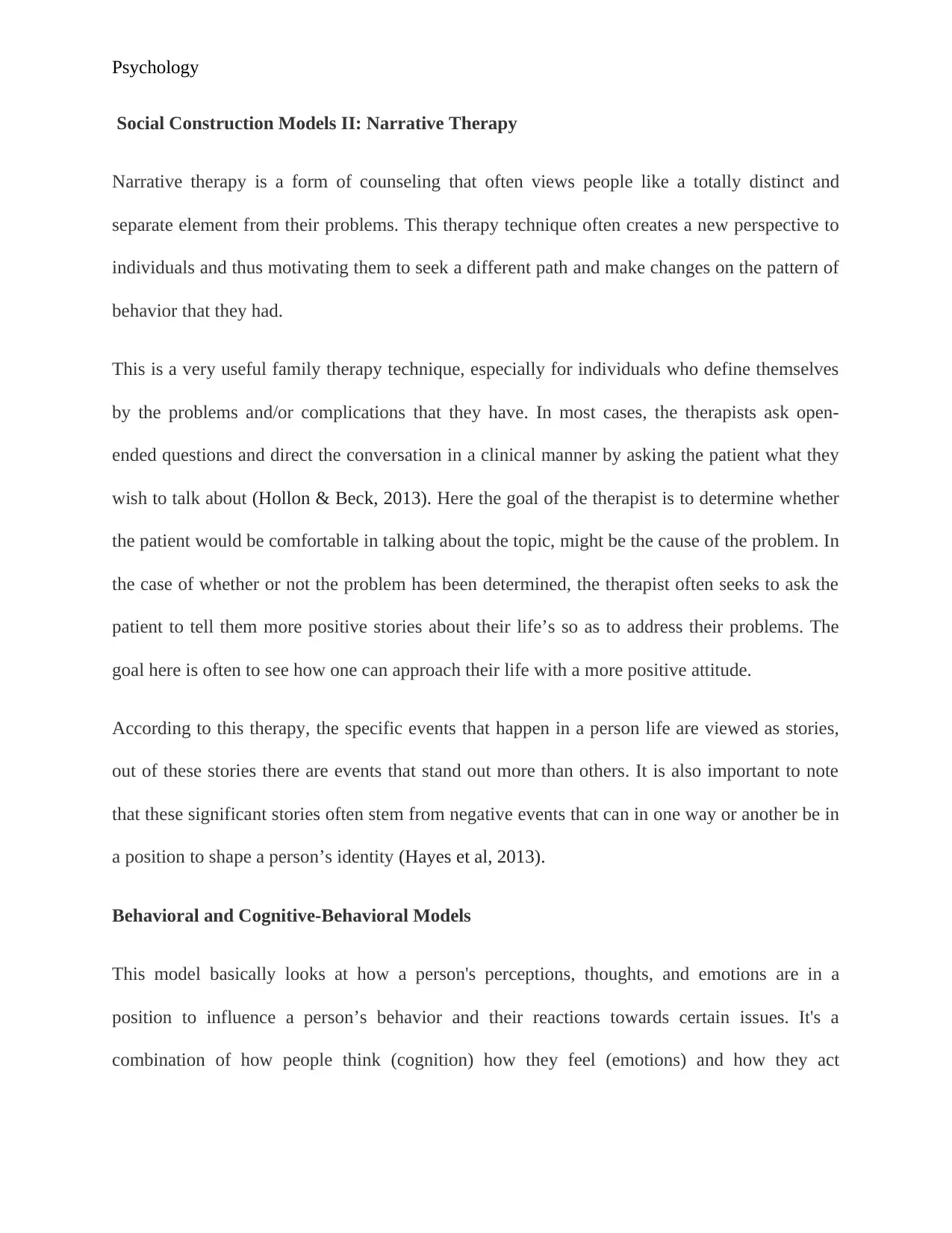
Psychology
Social Construction Models II: Narrative Therapy
Narrative therapy is a form of counseling that often views people like a totally distinct and
separate element from their problems. This therapy technique often creates a new perspective to
individuals and thus motivating them to seek a different path and make changes on the pattern of
behavior that they had.
This is a very useful family therapy technique, especially for individuals who define themselves
by the problems and/or complications that they have. In most cases, the therapists ask open-
ended questions and direct the conversation in a clinical manner by asking the patient what they
wish to talk about (Hollon & Beck, 2013). Here the goal of the therapist is to determine whether
the patient would be comfortable in talking about the topic, might be the cause of the problem. In
the case of whether or not the problem has been determined, the therapist often seeks to ask the
patient to tell them more positive stories about their life’s so as to address their problems. The
goal here is often to see how one can approach their life with a more positive attitude.
According to this therapy, the specific events that happen in a person life are viewed as stories,
out of these stories there are events that stand out more than others. It is also important to note
that these significant stories often stem from negative events that can in one way or another be in
a position to shape a person’s identity (Hayes et al, 2013).
Behavioral and Cognitive-Behavioral Models
This model basically looks at how a person's perceptions, thoughts, and emotions are in a
position to influence a person’s behavior and their reactions towards certain issues. It's a
combination of how people think (cognition) how they feel (emotions) and how they act
Social Construction Models II: Narrative Therapy
Narrative therapy is a form of counseling that often views people like a totally distinct and
separate element from their problems. This therapy technique often creates a new perspective to
individuals and thus motivating them to seek a different path and make changes on the pattern of
behavior that they had.
This is a very useful family therapy technique, especially for individuals who define themselves
by the problems and/or complications that they have. In most cases, the therapists ask open-
ended questions and direct the conversation in a clinical manner by asking the patient what they
wish to talk about (Hollon & Beck, 2013). Here the goal of the therapist is to determine whether
the patient would be comfortable in talking about the topic, might be the cause of the problem. In
the case of whether or not the problem has been determined, the therapist often seeks to ask the
patient to tell them more positive stories about their life’s so as to address their problems. The
goal here is often to see how one can approach their life with a more positive attitude.
According to this therapy, the specific events that happen in a person life are viewed as stories,
out of these stories there are events that stand out more than others. It is also important to note
that these significant stories often stem from negative events that can in one way or another be in
a position to shape a person’s identity (Hayes et al, 2013).
Behavioral and Cognitive-Behavioral Models
This model basically looks at how a person's perceptions, thoughts, and emotions are in a
position to influence a person’s behavior and their reactions towards certain issues. It's a
combination of how people think (cognition) how they feel (emotions) and how they act
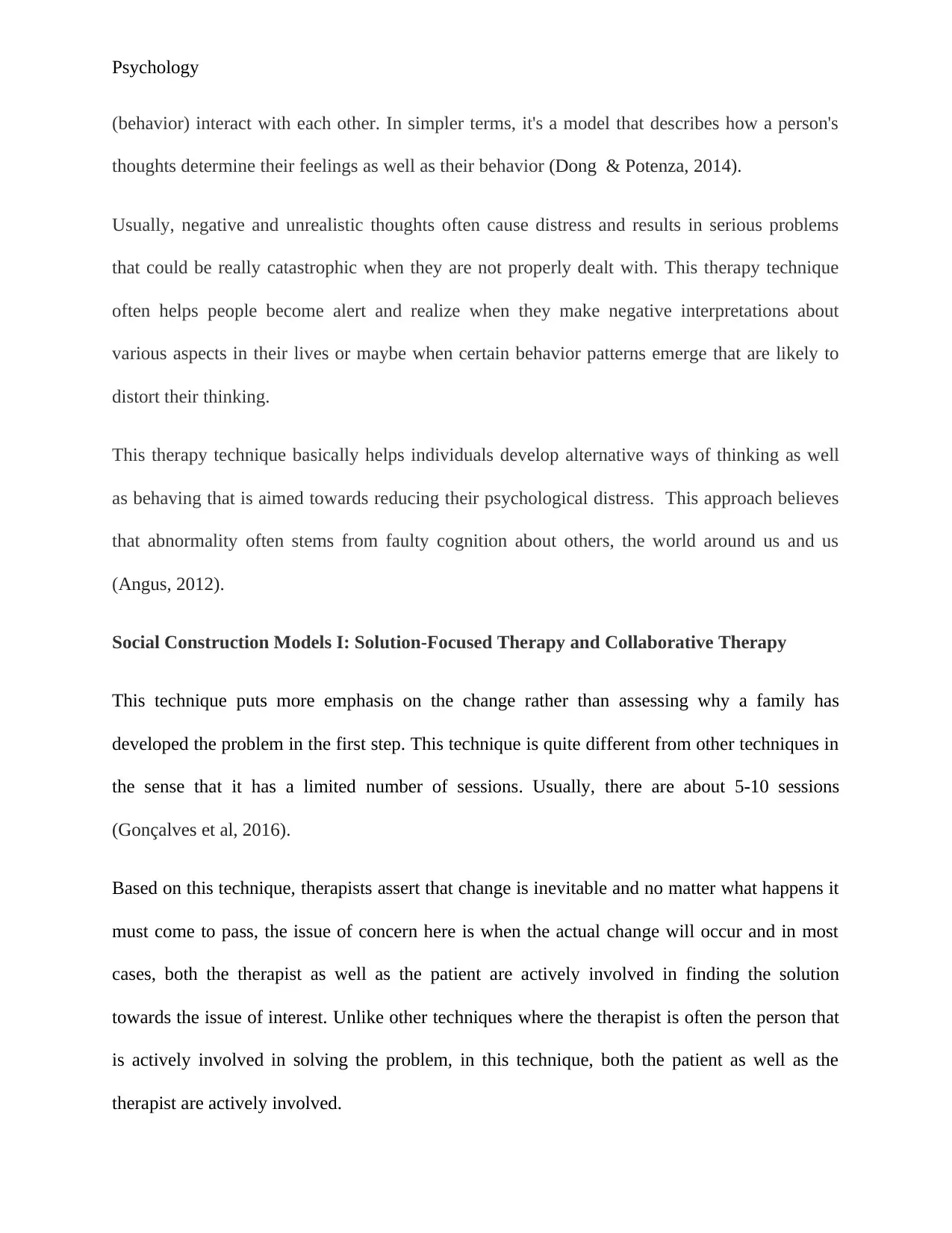
Psychology
(behavior) interact with each other. In simpler terms, it's a model that describes how a person's
thoughts determine their feelings as well as their behavior (Dong & Potenza, 2014).
Usually, negative and unrealistic thoughts often cause distress and results in serious problems
that could be really catastrophic when they are not properly dealt with. This therapy technique
often helps people become alert and realize when they make negative interpretations about
various aspects in their lives or maybe when certain behavior patterns emerge that are likely to
distort their thinking.
This therapy technique basically helps individuals develop alternative ways of thinking as well
as behaving that is aimed towards reducing their psychological distress. This approach believes
that abnormality often stems from faulty cognition about others, the world around us and us
(Angus, 2012).
Social Construction Models I: Solution-Focused Therapy and Collaborative Therapy
This technique puts more emphasis on the change rather than assessing why a family has
developed the problem in the first step. This technique is quite different from other techniques in
the sense that it has a limited number of sessions. Usually, there are about 5-10 sessions
(Gonçalves et al, 2016).
Based on this technique, therapists assert that change is inevitable and no matter what happens it
must come to pass, the issue of concern here is when the actual change will occur and in most
cases, both the therapist as well as the patient are actively involved in finding the solution
towards the issue of interest. Unlike other techniques where the therapist is often the person that
is actively involved in solving the problem, in this technique, both the patient as well as the
therapist are actively involved.
(behavior) interact with each other. In simpler terms, it's a model that describes how a person's
thoughts determine their feelings as well as their behavior (Dong & Potenza, 2014).
Usually, negative and unrealistic thoughts often cause distress and results in serious problems
that could be really catastrophic when they are not properly dealt with. This therapy technique
often helps people become alert and realize when they make negative interpretations about
various aspects in their lives or maybe when certain behavior patterns emerge that are likely to
distort their thinking.
This therapy technique basically helps individuals develop alternative ways of thinking as well
as behaving that is aimed towards reducing their psychological distress. This approach believes
that abnormality often stems from faulty cognition about others, the world around us and us
(Angus, 2012).
Social Construction Models I: Solution-Focused Therapy and Collaborative Therapy
This technique puts more emphasis on the change rather than assessing why a family has
developed the problem in the first step. This technique is quite different from other techniques in
the sense that it has a limited number of sessions. Usually, there are about 5-10 sessions
(Gonçalves et al, 2016).
Based on this technique, therapists assert that change is inevitable and no matter what happens it
must come to pass, the issue of concern here is when the actual change will occur and in most
cases, both the therapist as well as the patient are actively involved in finding the solution
towards the issue of interest. Unlike other techniques where the therapist is often the person that
is actively involved in solving the problem, in this technique, both the patient as well as the
therapist are actively involved.
⊘ This is a preview!⊘
Do you want full access?
Subscribe today to unlock all pages.

Trusted by 1+ million students worldwide
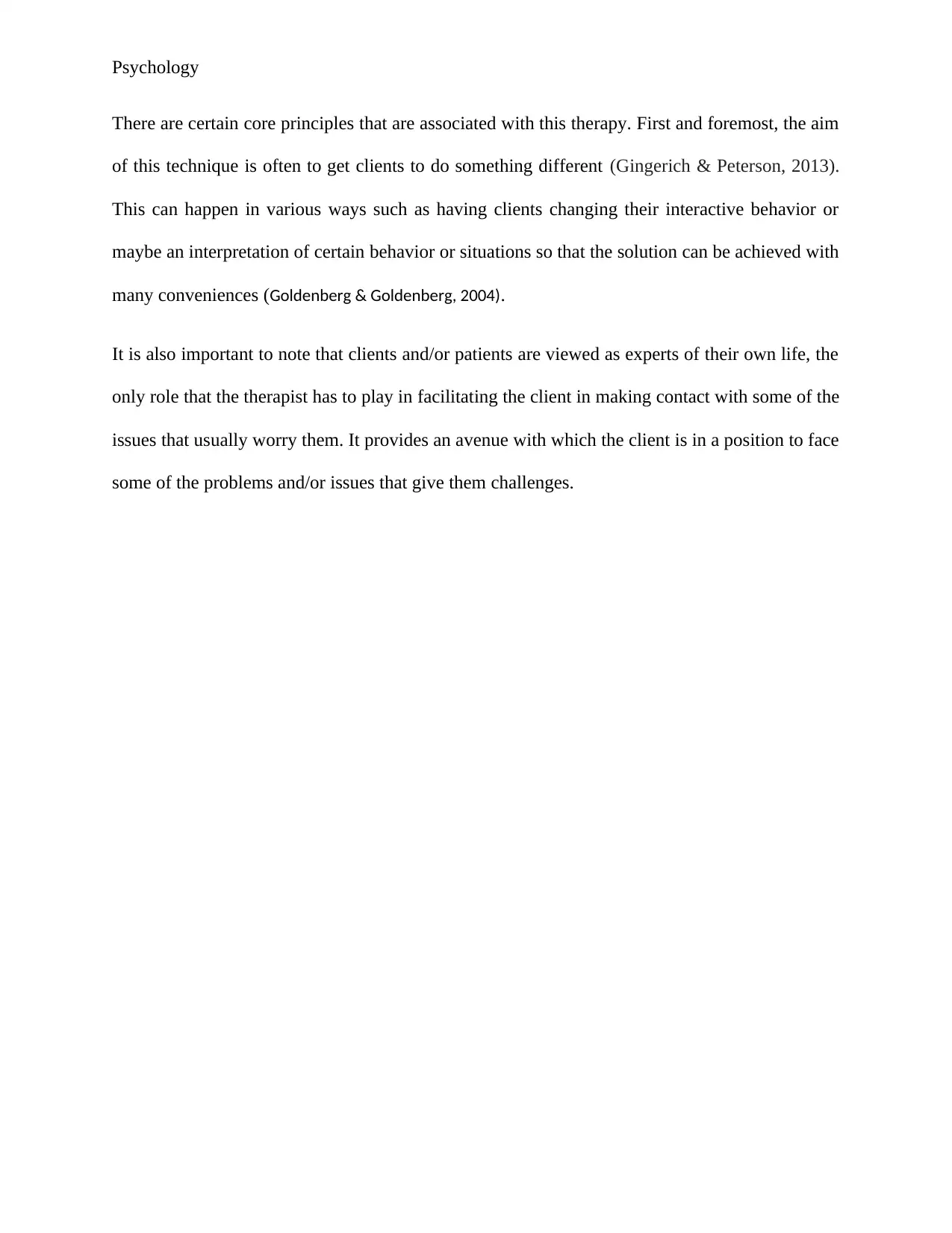
Psychology
There are certain core principles that are associated with this therapy. First and foremost, the aim
of this technique is often to get clients to do something different (Gingerich & Peterson, 2013).
This can happen in various ways such as having clients changing their interactive behavior or
maybe an interpretation of certain behavior or situations so that the solution can be achieved with
many conveniences (Goldenberg & Goldenberg, 2004).
It is also important to note that clients and/or patients are viewed as experts of their own life, the
only role that the therapist has to play in facilitating the client in making contact with some of the
issues that usually worry them. It provides an avenue with which the client is in a position to face
some of the problems and/or issues that give them challenges.
There are certain core principles that are associated with this therapy. First and foremost, the aim
of this technique is often to get clients to do something different (Gingerich & Peterson, 2013).
This can happen in various ways such as having clients changing their interactive behavior or
maybe an interpretation of certain behavior or situations so that the solution can be achieved with
many conveniences (Goldenberg & Goldenberg, 2004).
It is also important to note that clients and/or patients are viewed as experts of their own life, the
only role that the therapist has to play in facilitating the client in making contact with some of the
issues that usually worry them. It provides an avenue with which the client is in a position to face
some of the problems and/or issues that give them challenges.
Paraphrase This Document
Need a fresh take? Get an instant paraphrase of this document with our AI Paraphraser
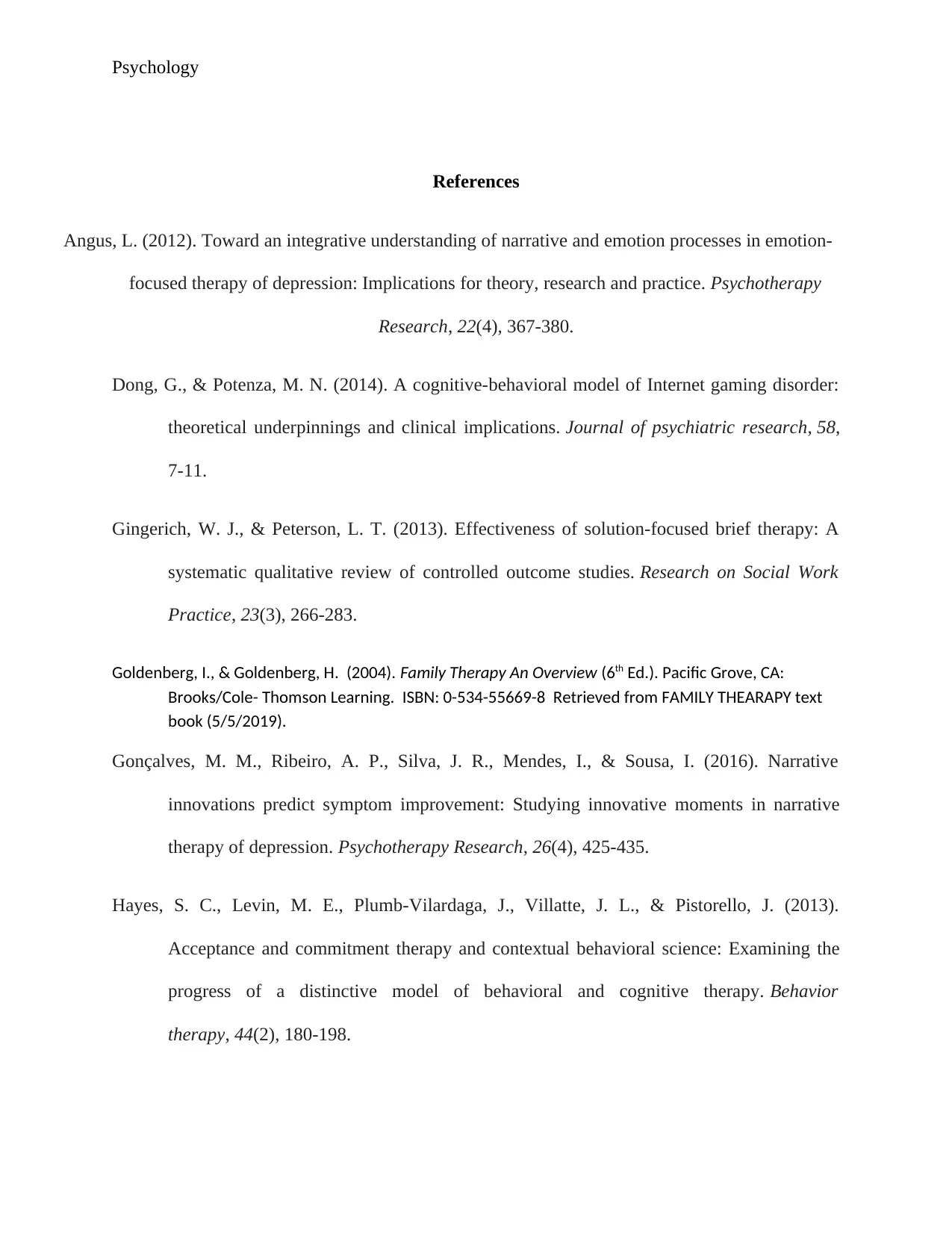
Psychology
References
Angus, L. (2012). Toward an integrative understanding of narrative and emotion processes in emotion-
focused therapy of depression: Implications for theory, research and practice. Psychotherapy
Research, 22(4), 367-380.
Dong, G., & Potenza, M. N. (2014). A cognitive-behavioral model of Internet gaming disorder:
theoretical underpinnings and clinical implications. Journal of psychiatric research, 58,
7-11.
Gingerich, W. J., & Peterson, L. T. (2013). Effectiveness of solution-focused brief therapy: A
systematic qualitative review of controlled outcome studies. Research on Social Work
Practice, 23(3), 266-283.
Goldenberg, I., & Goldenberg, H. (2004). Family Therapy An Overview (6th Ed.). Pacific Grove, CA:
Brooks/Cole- Thomson Learning. ISBN: 0-534-55669-8 Retrieved from FAMILY THEARAPY text
book (5/5/2019).
Gonçalves, M. M., Ribeiro, A. P., Silva, J. R., Mendes, I., & Sousa, I. (2016). Narrative
innovations predict symptom improvement: Studying innovative moments in narrative
therapy of depression. Psychotherapy Research, 26(4), 425-435.
Hayes, S. C., Levin, M. E., Plumb-Vilardaga, J., Villatte, J. L., & Pistorello, J. (2013).
Acceptance and commitment therapy and contextual behavioral science: Examining the
progress of a distinctive model of behavioral and cognitive therapy. Behavior
therapy, 44(2), 180-198.
References
Angus, L. (2012). Toward an integrative understanding of narrative and emotion processes in emotion-
focused therapy of depression: Implications for theory, research and practice. Psychotherapy
Research, 22(4), 367-380.
Dong, G., & Potenza, M. N. (2014). A cognitive-behavioral model of Internet gaming disorder:
theoretical underpinnings and clinical implications. Journal of psychiatric research, 58,
7-11.
Gingerich, W. J., & Peterson, L. T. (2013). Effectiveness of solution-focused brief therapy: A
systematic qualitative review of controlled outcome studies. Research on Social Work
Practice, 23(3), 266-283.
Goldenberg, I., & Goldenberg, H. (2004). Family Therapy An Overview (6th Ed.). Pacific Grove, CA:
Brooks/Cole- Thomson Learning. ISBN: 0-534-55669-8 Retrieved from FAMILY THEARAPY text
book (5/5/2019).
Gonçalves, M. M., Ribeiro, A. P., Silva, J. R., Mendes, I., & Sousa, I. (2016). Narrative
innovations predict symptom improvement: Studying innovative moments in narrative
therapy of depression. Psychotherapy Research, 26(4), 425-435.
Hayes, S. C., Levin, M. E., Plumb-Vilardaga, J., Villatte, J. L., & Pistorello, J. (2013).
Acceptance and commitment therapy and contextual behavioral science: Examining the
progress of a distinctive model of behavioral and cognitive therapy. Behavior
therapy, 44(2), 180-198.

Psychology
Hollon, S. D., & Beck, A. T. (2013). Cognitive and cognitive-behavioral therapies. Handbook of
psychotherapy and behavior change, 393-442.
Hollon, S. D., & Beck, A. T. (2013). Cognitive and cognitive-behavioral therapies. Handbook of
psychotherapy and behavior change, 393-442.
⊘ This is a preview!⊘
Do you want full access?
Subscribe today to unlock all pages.

Trusted by 1+ million students worldwide
1 out of 6
Related Documents
Your All-in-One AI-Powered Toolkit for Academic Success.
+13062052269
info@desklib.com
Available 24*7 on WhatsApp / Email
![[object Object]](/_next/static/media/star-bottom.7253800d.svg)
Unlock your academic potential
Copyright © 2020–2025 A2Z Services. All Rights Reserved. Developed and managed by ZUCOL.




